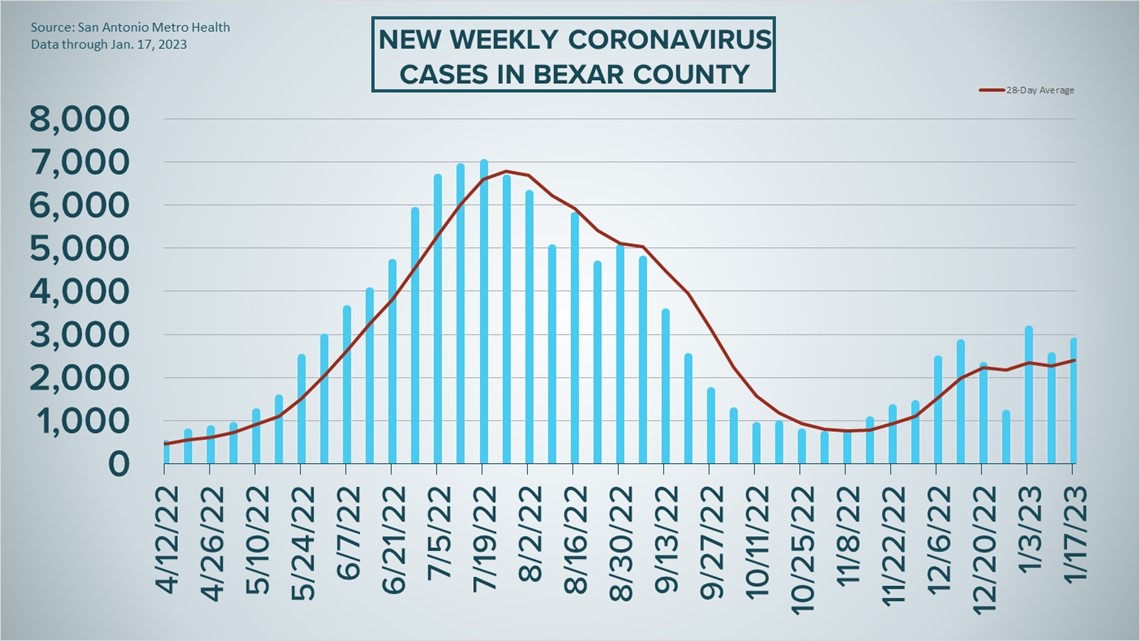SAN ANTONIO — San Antonio-area health officials have downgraded the urgency of the local COVID-19 situation to "steady" from "worsening" this week, but the risk level remains in the moderate threshold.
Metro Health is transitioning to weekly reports of coronavirus data for 2023. This week's numbers show that hospitalizations are down slightly, though a higher number of total cases was reported between Jan. 11 and Jan. 17 (2,841) compared to the week prior (2,497).
Nearly 670,000 coronavirus infections have been tallied in Bexar County since the pandemic began, but that figure likely doesn't include thousands of positive at-home tests that went unreported.
There were 246 patients hospitalized with COVID-19 symptoms in Bexar County on Tuesday, down by 27 from last week. Of those 246 patients, 48 were in intensive care.
Metro Health also reported seven more virus-related deaths in the last week, in addition to 50 additional backlogged deaths from coronavirus complications. At least 5,654 Bexar County residents have died from virus-related causes.
How Bexar County is trending


Vaccine progress in Bexar County
The following numbers are provided by San Antonio Metro Health via this page.
- 74.6% of eligible Bexar County residents (those over 6 months of age) are fully vaccinated as of Jan. 3.
- 11.3% of eligible Bexar County residents (those over 5 years of age) have received a bivalent booster as of Jan. 3
The CDC states that "when a high percentage of the community is immune to a disease (through vaccination and/or prior illness)," that community will have reached herd immunity, "making the spread of this disease from person to person unlikely."
The City of San Antonio breaks down the vaccination rates by zip code on Metro Health's Vaccination Statistics page.
Coronavirus in Texas
The Texas Department of State Health Services has also transitioned to weekly COVID-19 reports, with new data arriving every Wednesday.
For the week of Jan. 11 to Jan. 17, the state reported 26,357 cases; that total includes 14,861 new confirmed cases and 11,496 new probable cases. More details can be found on this page.
Those figures bring the total number of Texans diagnosed with COVID-19 to more than 8.21 million.
Meanwhile, 266 additional virus-related deaths were reported for the last week in Texas. The statewide death toll stands at 90,767. The positivity rate stands at 16.6%.
Coronavirus symptoms
The symptoms of coronavirus can be similar to the flu or a bad cold. Symptoms include fever or chills, cough, shortness of breath or difficulty breathing, fatigue, muscle or body aches, headache, new loss of taste or smell sore throat, congestion or runny nose, nausea or vomiting, and diarrhea, according to the Centers for Disease Control.
Most healthy people will have mild symptoms. A study of more than 72,000 patients by the Centers for Disease Control in China showed 80 percent of the cases there were mild.
But infections can cause pneumonia, severe acute respiratory syndrome, kidney failure, and even death, according to the World Health Organization. Older people with underlying health conditions are most at risk.
Experts determined there was consistent evidence these conditions increase a person's risk, regardless of age:
- Chronic kidney disease
- COPD (chronic obstructive pulmonary disease)
- Obesity (BMI of 30 or higher)
- Immunocompromised state (weakened immune system) from solid organ transplant
- Serious heart conditions, such as heart failure, coronary artery disease, or cardiomyopathies
- Sickle cell disease
- Type 2 diabetes
- The CDC believes symptoms may appear anywhere from two to 14 days after being exposed.
Human coronaviruses are usually spread...
- Between people who are in close contact with one another (within about 6 feet).
- Through respiratory droplets produced when an infected person coughs, sneezes or talks. These droplets can land in the mouths or noses of people who are nearby or possibly be inhaled into the lungs.
- Some recent studies have suggested that COVID-19 may be spread by people who are not showing symptoms.
Help stop the spread of coronavirus
- Stay home when you are sick.
- Eat and sleep separately from your family members
- Use different utensils and dishes
- Cover your cough or sneeze with your arm, not your hand.
- If you use a tissue, throw it in the trash.
Find a testing location
City officials recommend getting a COVID-19 test if you experience fever or chills, cough, shortness of breath or difficulty breathing, fatigue, muscle or body aches, headache, new loss of taste or smell, sore throat, congestion or runny nose, nausea or vomiting, or diarrhea.
Here's a Testing Sites Locator to help you find the testing location closest to you in San Antonio.

